 The North Devon coast holds very special memories for me and us, so it is always a pleasure to return and place our feet on such hallowed ground.
The North Devon coast holds very special memories for me and us, so it is always a pleasure to return and place our feet on such hallowed ground.This time was extra special for many reasons and I felt a real sense of place and belonging I hadn't felt as much before.
As a young man in the late seventies and early eighties we had holidays in this location with my parents. They seemed like exotic destinations to me then and now I realise that they were, even if they were still in the confines of the British Isles, there are wonders to be seen in all parts of the world and I hold those holidays very dear to my heart. So it was extra special to revisit these places as a middle aged man with my new partner by my side in the beginning of the 21st Century.
Sarah's Mum and Dad retired to Northam, near Bideford in 2001 so we got to know the area very well. Matters of life conspired them to move near to us in Hampshire in 2015 but friends and reasons of the heart inspire us to return, plus the sheer love of the place.
Sarah, her mother Doreen and I had booked a chalet at the famous holiday resort of Braddicks in Westward Ho! (Note the exclamation mark... the only one after a place in Britain) in October. They are very well appointed and command fantastic views across Bideford Bay.
We had decided on a visit to coincide with the anniversary of the scattering of my Father in Laws ashes on the sand dunes here and to pay homage.
The day after our arrival, Sarah and I decided on a walk to a place called The Skern on Northam Burrows which is a peninsular protecting the estuary of Bideford and Barnstaple, where the rivers of the Taw and Torridge combine and spill out into the bay. On the West side of The Burrows sits Westward Ho! beach, a long and perfectly sandy stretch of Devon coastline bordered by the famous pebble ridge.
The view here is looking towards the idyllic seaside village of Appledore to the East.
Being October, it is the migration season. The majority of birds at this time are in the mood to leave our shores with a few arriving. Wheatear breed here in the sand dunes by the golf course and this one decided to hang around for a portrait on the boulders as we meandered along the shore.
We had reached a very special place along the dunes. A place where in 2012 we had scattered the ashes of Sarah's sister Debra and her husband David and subsequently Sarah's Father Frank in 2016.
As we approached the area, an aircraft distracted us from above. I joked to Sarah that this was her Dad coming to say hello.
It wasn't until after I had returned from our walk that I looked in detail at the photo. The aircraft in question was a Tiger Moth. Not any old Tiger Moth I hasten to add. The picture on Franks order of service shows him standing in front of a Tiger Moth, resplendent in the very same colour and would you believe, the exact same aircraft. Frank I may add, had a passion for all things to do with aviation so look unto this what you will. A coincidence maybe, one heck of one I say?!
Even without confirmation at the time, we were quite taken aback with the spiritual essence and meaning in that moment. It stayed with me as Sarah left to head back to the chalet by car as I continued around the beach towards Westward Ho! on foot. The Wheatear stayed with me too as I trod a path along the dunes and down to the vast expanse of sandy beach.
The vast pebble ridge edges the sandy shore that shelves towards the incessant roaring breakers where the Bristol Channel and Atlantic Ocean converge and slip back and forth in time with the tide.
The cloud cover was virtually total all day, except as I made my way along the vast expanse of shore.
The light was seeming to draw me forwards towards the incoming tide.
It was here that I felt a real sense of place and of spirits. I wasn't alone on my walk here...
I knelt down to grab some photos of the boiling sea and this was on a relatively calm day. It was too easy to get caught out by the water as it edged ever closer very quickly.
This is a popular place for surfing no matter what the time of year.
Halfway through the beach walk I could see - with a little help of binoculars and a telephoto lens- our chalet nestled against the side of the hill. Sarah was standing outside waving a towel in this shot although I haven't zoomed in far enough to see her.
Along the shore were a few gulls. Mainly Black Headed but I picked out a rarer Mediterranean Gull taking morsels from the surf. The light and reflection combined for some pleasing pictures. I lost myself in the moment.....
The comparison between the Black Headed and Mediterranean worked perfectly here. The Black Headed in the background has black tips to the tail and much slender bill compared with the Med Gull in the foreground.
I had reached the end of the shore just in time as the tide was almost up to the pebble ridge.
A short, sweet and very emotional walk. The end of the day with a lovely evening ahead to catch up with good friends and reflect on a most surreal few hours.
My second day out walking was to be one on foot from the start.
I left our chalet early. Sarah was out with her Mum so I had the day to myself.
The waterfront at Westward Ho! is changing and modernising from the dilapidated throwback seaside town it used to be, to one more suited to the 21st century and scattered with a plethora of second homes for people with disposable incomes.
Jackdaws - ever the opportunists - were looking for easy meals along the sea wall.
The magnificent island of Lundy was quite visible today. We have visited once and I thoroughly recommend this to anyone. We would love to go back one day...
In stark contrast to yesterday, the tide was well in on the beach and pebble ridge was receiving a bashing.
Rather than walk along the beach I decided on a route diagonally towards Appledore in the hope a finding some decent coffee. I'm a simple chap with simple pleasures after all...
The Starlings were gathering en masse along the wires by the entrance to The Burrows ready for the days feeding..
The Brown Lipped Snail or Grove Snail took my eye along the path as I wandered towards Appledore...I had no luck finding a place open for real coffee thus far and my need of its consumption grew ever more acute...
When the tide is out I normally walk diagonally across to Appledore from here but today I had to walk an unfamiliar but interesting route along the cliff path.
There are a couple of derelict houses edging the cliff. They always make me wonder who was last to inhabit them and the lives spent in there?
Evening Primrose still flowered along the path...
Reaching the village, the colours of the narrow streets always remind me of programmes like Trumpton as a child.
The local run delicatessen of Johns is a great place to grab a snack and a decent coffee....at last !
I sat drinking my beverage and admiring the view across the Torridge River to Instow
A Black Headed Gull snoozed on one of the boats as Oystercatchers shot up the river towards Bideford.
I could follow these birds to get to my destination at Fremington Quay on the opposite side but I didn't think I could make the journey there on foot and back again, so I cheated and ordered a taxi.
The lady driver was very engaging and gave me her life story in the 15 minute car ride I neither wanted or asked for but I was polite and nodded in the right places and tipped accordingly.
Relief was all consuming as I exited the car and continued my solo sojourn along the road into Fremington.
The first sighting was the ever reliable Little Egret in the creek leading to the estuary. The tide was receding quite quickly and my hope of the rare bird I was seeking was diminishing by the minute.
Next along were three Greenshank. The ghost waders of the marsh.
Their cousin the Redshank are the most numerous here
They can be seen everywhere along the tide line feeding.
Curlew are a common sight also. However, they have been red listed as birds of conservation concern due to their steep decline in numbers in the last few years. As so often in recent times, birds seen so frequently and taken for granted are vanishing before us. I couldn't imagine the day when I don't hear the ethereal call of a Curlew on a winter walk.
With so many Redshank dominating the tide line it's all to easy to miss a different species feeding. A sharp eye is required to pick out something that walks and feeds in a different manner. A Common Sandpiper is easily missed camouflaged against the mud.
The estuary of the Taw River that flows to the left and meets the Torridge has the propensity to throw up some wonderful sights.
In recent weeks a rare Glossy Ibis had been seen here. In fact up to seven were seen feeding in the summer. In the last month 'Billy no mates' was the last to stay. I was hopeful of my first sighting of one. I had tried a number of years ago in the New Forest without luck so maybe this was my time?
The old station forms part of the Tarka Trail and incorporates a bicycle hire and repair shop plus a museum and excellent cafe with very friendly staff. Well worth a visit and I can thoroughly recommend the fish pie.
Search as I might, the Ibis had given me the slip once again. To rub salt into the wounds a passer by asked me if I had seen it and then proceeded to explain how good a view he had got not 2 hours previously. I congratulated him with as little jealousy and patronage in my voice as I could muster.
I mooched off just a little disgruntled following the old railway line into Instow.
A Buzzard helped me distract my mind from chances missed...
Nearing Instow there were some interesting rail side cabins which looked very cosy and inviting.
I retired to a local hostelry and relieved them of some fine ale to quench my thirst.
Jackdaws chuckled all around the rooftops as I supped my beer and pondered my wonderful sights and missed opportunities from the last few hours.
I was now on the opposite bank from this morning. Appledore looked resplendent as I sat on the sea wall awaiting my second female taxi driver of the day.
Looking North, Braunton Burrows stood imposing across the Taw River. This is used as a training area for the MOD. It is a place all too easy to get lost in. Something I can vouch for....
My taxi driver had arrived. The cost for this journey was around £1.50 or half a pint of cider. A bargain I'd say, especially as this person was my Sarah and not only the best looking taxi driver of the day by far but also the cheapest. Double bubble as the saying goes... Ibis..what Ibis..?
Day 3 :
I was planning to treat Sarah to a meal at Fremington today but she wasn't feeling too bright so I nipped off for a second bite at another possible Ibis cherry.
On my way I diverted to The Skern to see what was around.
As I parked on the grass verge a large flock of Golden Plover flew around as undecided as ever as to where to land.
Some settled out on the marsh ahead of me along with a few Brent Geese that stay here for the winter.
There were a real liquorice mix of wader roosting, waiting for the tide to recede.
I could make out Oystercatcher, Curlew, Golden Plover, Bar Tailed Godwit, Brent Goose and Grey Plover.
Next destination was back to Fremington.
It's a fascinating area not just for nature but for local history too. It is situated 3 miles west of Barnstaple and used to be a port on the river Taw. It was formerly a borough and sent members to Parliament in the reign of King Edward III (1327 - 77)
Fremington is also famous for Fishley Pottery. The quay here was once significant in the import and export of goods including ball clay and coal, encompassing railway sidings and cranes. In the early to mid twentieth century it was the busiest port (based on tonnage) between Bristol and Land's End.
It now has a restaurant, bike repair and hire as I have mentioned and has been a conservation area since 1996. It really does have an air of history surrounding it and makes you want to dig deeper. The Tarka trail cycle route passes through and is well worth checking out if you plan a trip here.
I parked out on the main road and walked the single track road into the Pill. It's well worth doing this as you see the whole river that runs out into the Taw estuary and it can reveal some lovely sights.
My first lovely sight was a male Sparrowhawk. The first thing I heard was the alarm calls of the birds all around me. I knew immediately a bird of prey was out hunting.
It zipped past my head and took up residence in the trees on the opposite side of the river.
I couldn't get any better views so I trudged off towards the quay.
Still the main bird on the block was the Redshank. Also called the sentinel of the marsh as it is usually the first to exclaim a word of warning, even if it is my own presence.
I passed by the restaurant on the quay in the old station and ventured further up the Tarka Trail towards Barnstaple. A place I remember all too well. I spent a night in the hospital here in 2014. Another excellent local hospital in danger of losing it's brilliant A&E department.
I was still on the lookout for that elusive Glossy Ibis. Who knows were it could be in the expanse of the estuary?
A Herring Gull was doing a great job of dismembering a shore crab as I walked the old track.
The unmistakable 'Cronking' of Ravens span me around to the heavens above.
And as if heaven sent, a rainbow followed me up the River Taw, highlighting the roosting and feeding birds along the mudflats as the tide receded. I was focused on this multicoloured light refraction, expecting my pot of Ibis gold beneath it....
Curlew were prominent here and one got close to me by the shore as it looked for food.
So did a Black Headed Gull. I watched one find what seemed to be a flatfish, possibly a Dab in the mud.
It took quite a while to consume it's prey. No doubt of the width it had to deal with..
I was getting to the point of return.
The exposed mud was accentuated and expanded near Barnstaple Bridge. This was a perfect place to stop and observe the waders taking the opportunity to feed.
Two waders can be very difficult to tell apart. In a word...Godwits. I've always loved the name. Possibly my favourite avian moniker. It hovers on the verge between sainthood and profanity for me. I'll let you be the judge...
The best way of definition between the two is in flight. My friend Chris's favourite photographic position ...
The checkered pattern on the tail (or barred) is a dead giveaway.
To confuse the issue, there were many Black Tailed amongst them. Good grief it can be so hard this nature lark!
As they lifted off it was obvious to their origin.
The end of my wonderful walk was nigh. I try to appreciate, imbibe and prolong my stay in wonderland as much as my conscious being allows me. These are my cherished away days from my working week, those days we remember the most in our conscious and subconscious.
Half a mile to the car and my hope of seeing an Ibis - glossy or not - was subsiding faster than the tide.
The regular Greenshank or the 'Fremington Three' (or 'Fremington Free' in cockney slang) as I had dubbed them, roosted full bellied on the muddy shore.
I'm average to good at recognising certain shapes in the natural world, including ones I haven't had the fortune to cross before - you just get to know an animal from years trawling across reference books, programmes and magazines etc.
Of all the walking, hearing and hoping over the last two days, here it was in all it's glossy glory....eating nonchalantly in the clay....expletives bubbled forth and my legs convulsed into forward motion in the hope of closer contact.
It didn't disappoint. Regardless of what might transpire, you keep taking photos as if it was going to be your last, just in case the subject exits abruptly.
The subject in question - after many weeks in the vicinity- wasn't going anywhere.
Being a dark coloured bird it contrasted well against the silted background but to reveal it's true glory you need to get in closer with light in your favour.
The glossy hued colour only becomes apparent when the light refracts off it's plumage ...the end of the rainbow one might reflect?
A common species in Mediterranean regions, the first breeding attempts were made in Britain at Frampton Marsh in Lincolnshire in 2014. Another example of warming temperatures pushing species to breed further North than before.
I was lucky enough to catch it again in flight against a darker background that could enhance it's plumage.
Another former 'Exotic' species now so common, joined in on a feeding foray. Whatever the Ibis disturbed was potential food for the Egret and it shadowed it constantly.
Almost always downstream too, you might notice, to catch any disturbed prey as the tide regressed...
After all the searching and inspiring sights along my travels, the bird at the forefront of my mind was the last to show. One hell of a climax and a pleasure to reside in it's company. 
Still aware however, of the fact given another decade, this could likely be as common as a Little Egret and hopefully we'll be as appreciative then as we are now?
I climbed back into the car pondering this thought and drove back to Westward Ho!
The views across to the beach were awe inspiring as ever, lit up by the evening sun.
I wasn't done though. I wanted to walk the moor above our chalet on such an inspiring evening.
Kipling Tor is managed by the National Trust and nestles behind our chalet. The Trust has had contentious issues of late regarding practices on it's land. I'm not a member and torn between happiness and sadness of that fact upon the recent apparent 'democratic' decisons made about hunting on it's properties.
In the foreground here, what has been known as the 'spooky house' for years has been recently sold at auction and aquired by the boss at Braddicks, seemingly keeping it in local hands. It's fate has yet to be decided. It stands as a monument to times and lives past and I fear it will be demolished. The cost of it's renovation far more than it's prospective site is worth and it's return.Yet I feel the heart of it's new owner - given his heritage- will over rule his head. That is my fervent hope anyway.
I climbed Kipling Tor, ever higher, commanding unsurpassed views across to Northam Burrows, Appledore and Barnstaple beyond.
The lookout pillbox at the top was the final stop. Lundy was just about visible to the north west, in case you had doubts...
Several spiritually inspiring days in the South West yet again and the last it would seem this year. I've had some life affirming times here.
Quite a high note to leave this part of the world on.
The title of this post is a line taken from the poem 'The Glossy End of a New Adventure' by Jay Bradley
























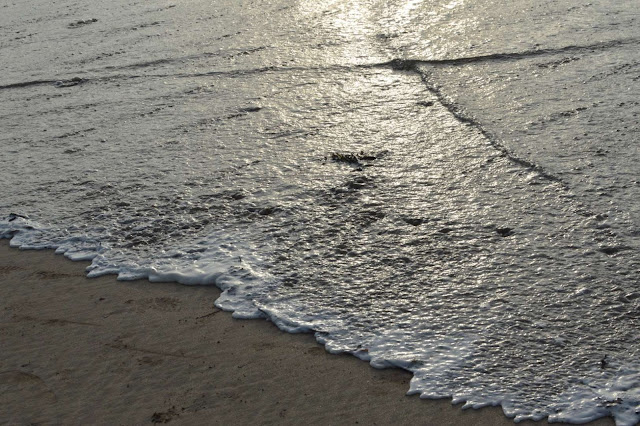

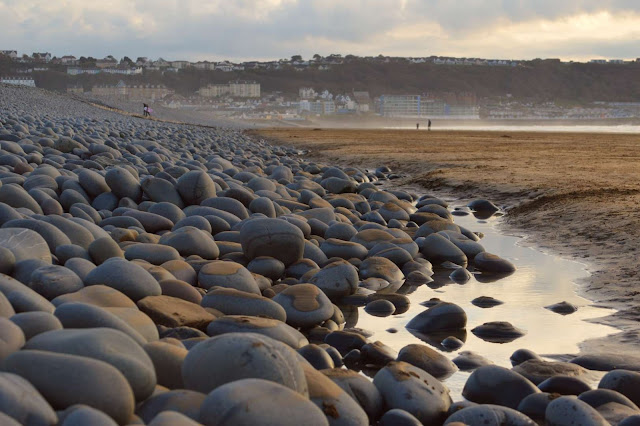
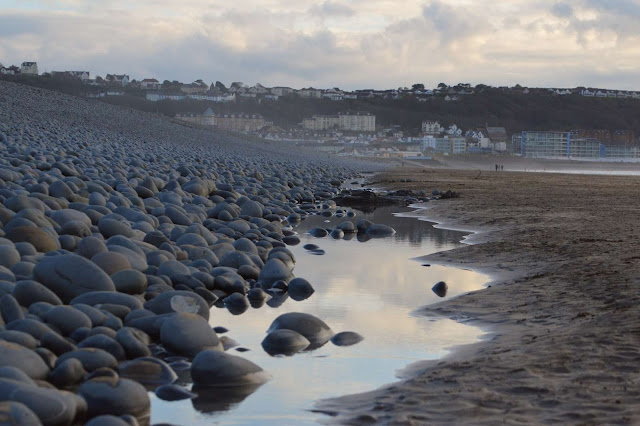















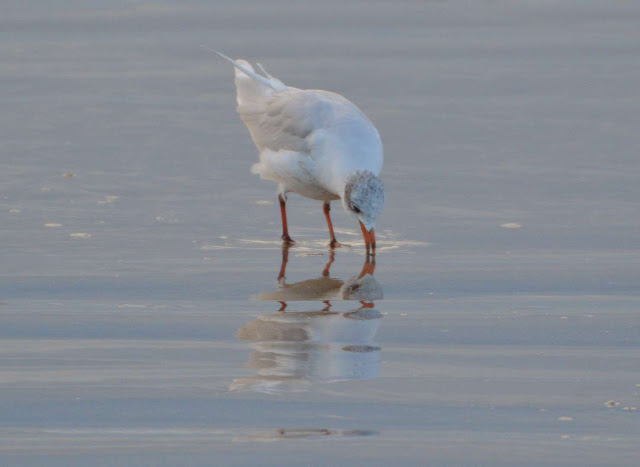








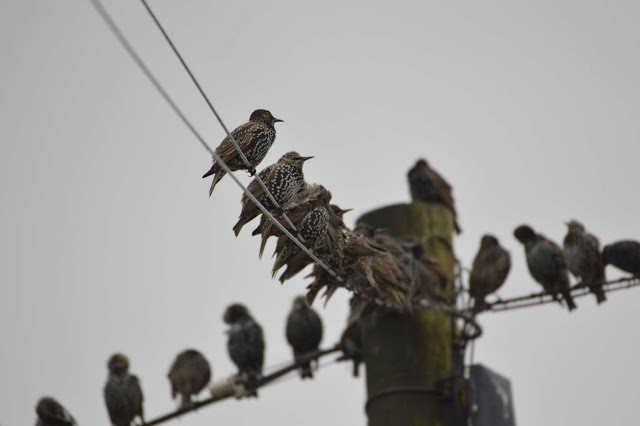






















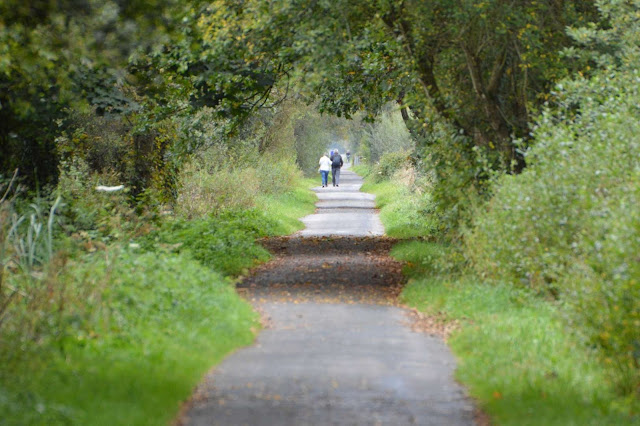



























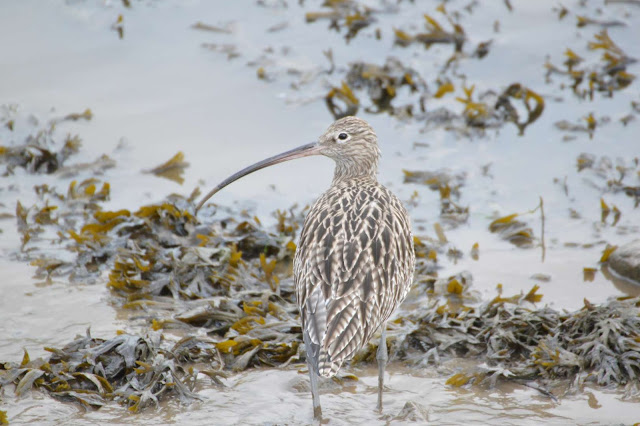








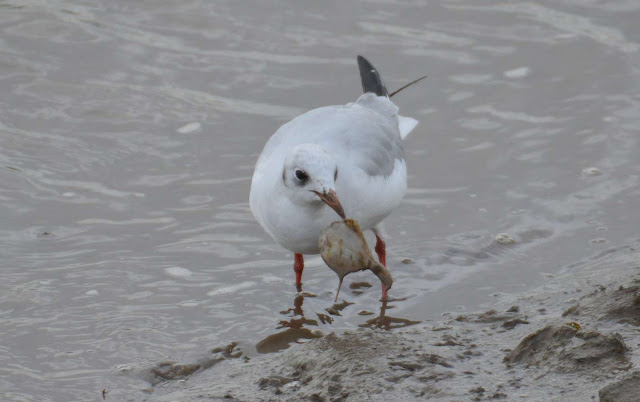

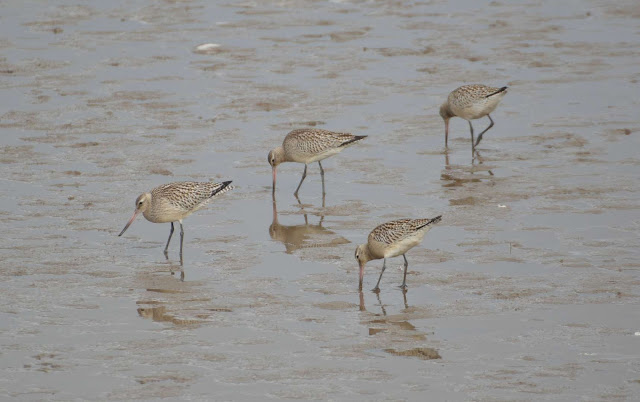







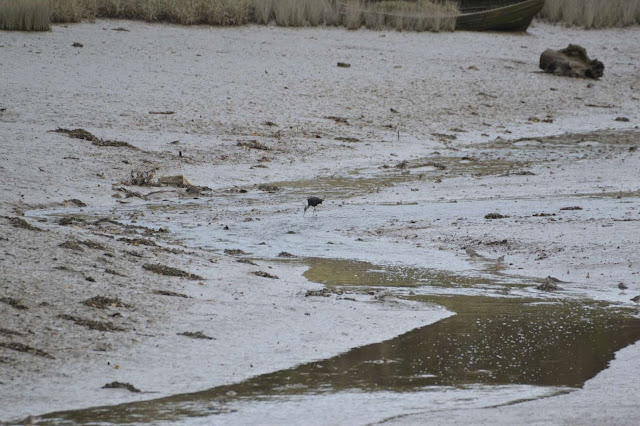
















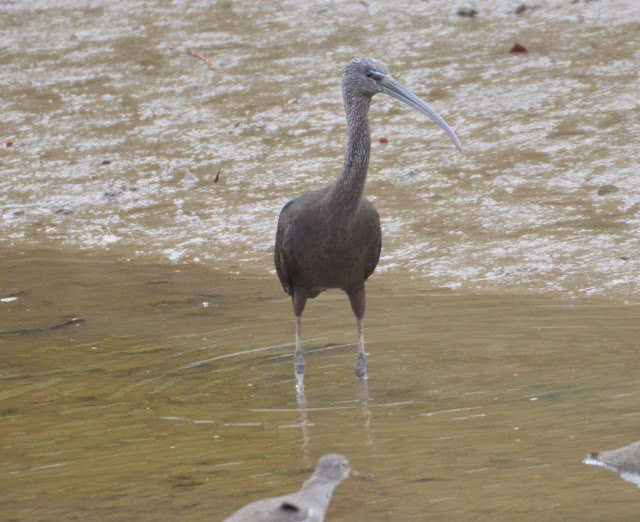












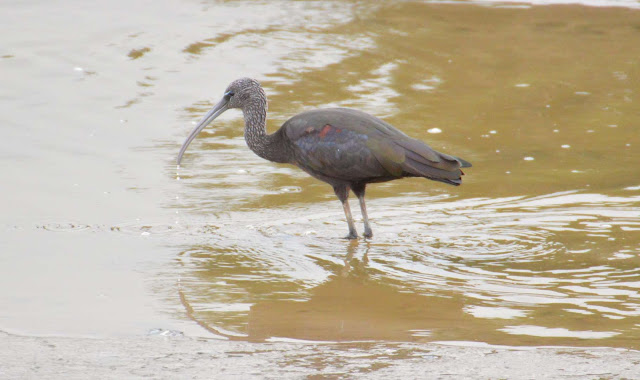








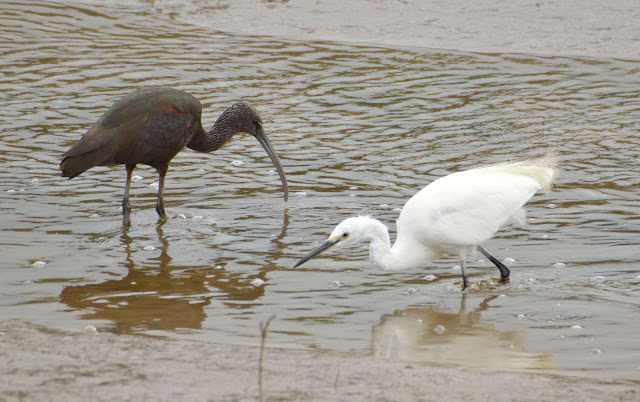













Since when have I had a passion for flight photography? Godwits were a very common 17th century dish, and the name Godwit comes from "God" meaning "good" and "wit" which comes from "wihte" which meant "creature".
ReplyDeleteLove the building tension leading to the eventual find of the ibis!